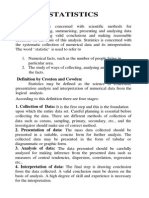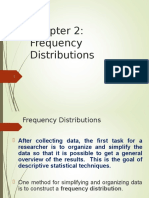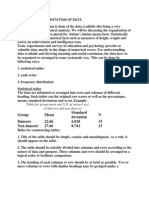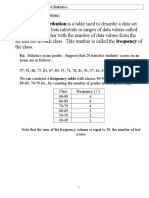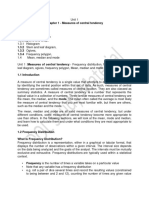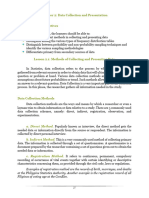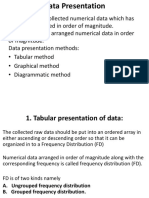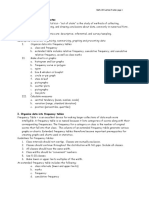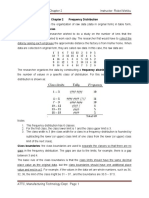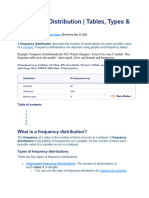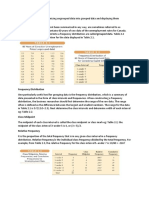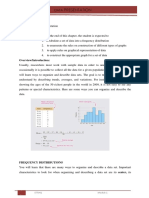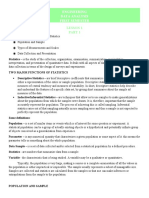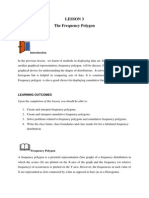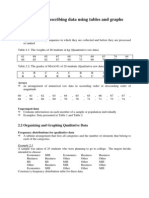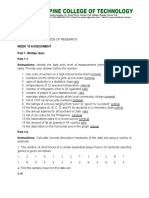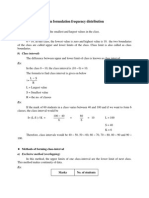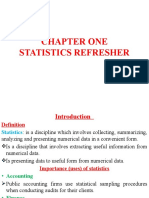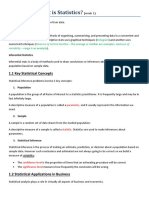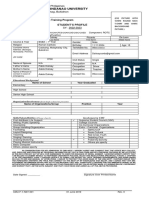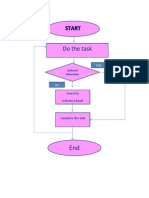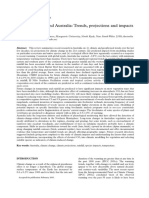Hand Out2 Data Presentation 1
Hand Out2 Data Presentation 1
Uploaded by
Caryl GalocgocCopyright:
Available Formats
Hand Out2 Data Presentation 1
Hand Out2 Data Presentation 1
Uploaded by
Caryl GalocgocCopyright
Available Formats
Share this document
Did you find this document useful?
Is this content inappropriate?
Copyright:
Available Formats
Hand Out2 Data Presentation 1
Hand Out2 Data Presentation 1
Uploaded by
Caryl GalocgocCopyright:
Available Formats
Psychological Statistics Stat 25 Teachers
METHODS OF DATA PRESENTATION
2.1 Things to Know
(1) Raw data are data collected that have not been organized numerically.
(2) An array is an arrangement of raw numerical data in ascending or descending order of
magnitude. The difference between the largest and smallest numbers is called the range of
the data.
(3) Two general methods in presenting data: tabular presentation and graphical presentation.
(4) Tabular Presentations may be in the form of a cross tabulation table, a frequency distribution,
or a stem-and-leaf plot. Some of the statistical graphs are the bar chart, histogram, frequency
polygon and the box and whisker plot.
(5) Cross tabulation table – when data are in categories, data are arranged in rows and columns.
- information gathered has only a small number of values, like a “yes” or “no” answer or
the gender of the respondent. - these categories are arranged in a row or column and the
appropriate information, oftentimes in frequencies or percentages, are placed in suitable
cells.
2.2 Frequency Distribution Table
Frequency Distribution – is a grouping of all the observations that fall in each interval or class.
Suggested number of intervals is from 6 to 15 intervals.
Guide for finding the number of intervals:
k = or k = 1 +
where k = number of intervals
n = number of observations
is the logarithm of n taken to the base 10.
Note: the results are rounded off to the next higher integer, so that it can accommodate all
the observations.
Steps in Constructing a Frequency Distribution
1. Find the range R where R = highest value – lowest value.
2. Estimate the number of classes,
3. Estimate the width c of the interval by dividing the range R by the number of classes Round off
this estimate to same number of significant decimal places as the original set of data.
First Semester page 1 of 10
Psychological Statistics Stat 25 Teachers
4. List the lower and upper class limits of the first interval. This interval should contain the
smallest observation or any number closest to it.
5. List all the class limits by adding the class width to the limits of the previous interval.
6. Compute the class marks and the class boundaries. Class boundaries should not coincide with
the actual observed data.
7. Tally the frequencies of each class.
Example 2. Table 2.1.2 is a frequency distribution of heights (recorded to the nearest inch) of 100
male students at XYZ University.
Table 2.1.2: Heights of 100 Male Students at XYZ University
HEIGHT (IN) NUMBER OF STUDENTS
60-62 5
63-65 18
66-68 42
69-71 27
72-74 8
Total 100
8. Class intervals and class limits
A symbol defining a class, such as 60-62 in Table 2.1.2, is called a class interval. The end numbers,
60 and 62, are called class limits; the smaller number (60) is the lower class limit, and the larger
number (62) is the upper class limit.
A class interval that, at least theoretically, has either no upper class limit or no lower class limit
indicated is called an open interval. For example, referring to age groups of individuals, the class
interval “65 years and over” is an open class interval.
9. Class Boundaries
For example the heights are recorded to the nearest inch, the class interval 60-62 theoretically
includes all measurements from 59.5000 to 62.5000 in. These numbers, indicated briefly by the
exact numbers 59.5 to 62.5, are called class boundaries, or true class limits; the smaller number
(59.5) is the lower class boundary, and the larger number (62.5) is the upper class boundary.
In practice, the class boundaries are obtained by adding the upper limit of one class interval to the
lower limit of the next-higher class interval and dividing by 2.
First Semester page 2 of 10
Psychological Statistics Stat 25 Teachers
Sometimes, class boundaries are used to symbolize classes. For example, the various classes in the
first column of Table 2.1.2 could be indicated by 59.5-62.5, 62.5-65.5, etc.
To avoid ambiguity in using such notation, class boundaries should not coincide with the actual
observations.
10. The size or width of a class interval The size or width of a class interval is the difference
between the lower and upper class boundaries and is also referred as the class width, class size,
or class length. This can be also obtained by getting the difference between two successive lower
class limits or two successive upper class limits.
11. The class mark The class mark is the class midpoint of the class interval and is obtained by
adding the lower and upper class limits and dividing by 2. The class mark is also called the class
midpoint. For purposes of further mathematical analysis, all observations belonging to a given
class interval are assumed to coincide with the class mark. Thus all heights in the class interval
60-62 in are considered to be 61. in.
12. Relative Frequency Distribution – the frequencies found in the frequency table is replaced by
relative frequencies. - the relative frequency for each interval is obtained by dividing the class
frequency by the total frequency.
13. Percentage Distribution – if the relative frequency of each class is expressed in percent.
14. Cumulative Frequency Distribution – the cumulative frequency associated with the upper
class boundary of a particular interval is computed by summing the frequency for that interval
and the frequencies of all the intervals below it.
2.3 GRAPHICAL METHODS
All of the graphical methods shown in this section are derived from frequency tables. Table 1
shows a frequency table for the results of the iMac study; it shows the frequencies of the various
response categories. It also shows the relative frequencies, which are the proportion of responses
in each category. For example, the relative frequency for “none” of 0.17 = 85/500
First Semester page 3 of 10
Psychological Statistics Stat 25 Teachers
Pie Charts
The pie chart in Figure1 shows the results of the iMac study. In a pie chart, each category is
represented by a slice of the pie. The area of the slice is proportional to the percentage of responses
in the category. This is simply the relative frequency multiplied by 100. Although most iMac
purchasers were Macintosh owners, Apple was encouraged by the 12 of purchasers who were
former Windows users, and by the 17 of purchasers who were buying a computer for the first
time.
Pie charts are effective for displaying the relative frequencies of a small number of categories.
They are not recommended, however, when you have a large number of categories. Pie charts
can also be confusing when they are used to compare the outcomes of two different surveys or
experiments.
Bar Charts
Bar charts can also be used to represent frequencies of different categories. A bar chart of the
iMac purchases is shown in Figure2. Frequencies are shown on the Y − axis and the type of
computer previously owned is shown on the X − axis. Typically, the Y − axis shows the number
of observations in each category rather than the percentage of observations in each category as is
typical in pie charts
First Semester page 4 of 10
Psychological Statistics Stat 25 Teachers
Summary
Pie charts and bar charts can both be effective methods of portraying qualitative data. Bar charts
are better when there are more than just a few categories and for comparing two or more distribu-
tions.
2.3.1.Graphing Quantitative Variables
There are many types of graphs that can be used to portray distributions of quantitative variables.
The upcoming sections cover the following types of graphs: (1) stem and leaf displays, (2) his-
tograms, (3) frequency polygons, (4) box plots, (5) bar charts, (6) line graphs, (7) dot plots, and
(8) scatter plots (discussed in a different chapter). Some graph types such as stem and leaf dis-
plays are best-suited for small to moderate amounts of data, whereas others such as histograms
are bestsuited for large amounts of data. Graph types such as box plots are good at pg. 44 depict-
ing differences between distributions. Scatter plots are used to show the relationship between two
variables.
Stem and Leaf
A stem and leaf display is a graphical method of displaying data. It is particularly useful when
your data are not too numerous. In this section, we will explain how to construct and interpret this
kind of graph. As usual, we will start with an example. Consider Table 2 that shows the number
of touchdown passes (TD passes) thrown by each of the 31 teams in the National Football League
in the 2000 season.
First Semester page 5 of 10
Psychological Statistics Stat 25 Teachers
A stem and leaf display of the data is shown in Figure 7. The left portion of Figure 1 contains the
stems. They are the numbers 3, 2, 1, and 0, arranged as a column to the left of the bars. Think
of these numbers as 10’s digits. A stem of 3, for example, can be used to represent the 10’s digit
in any of the numbers from 30 to 39. The numbers to the right of the bar are leaves, and they
represent the 1’s digits. Every leaf in the graph therefore stands for the result of adding the leaf to
10 times its stem.
Histograms
A histogram is a graphical method for displaying the shape of a distribution. It is particularly
useful when there are a large number of observations. We begin with an example consisting of the
scores of 642 students on a psychology test. The test consists of 197 items each graded as “correct”
or “incorrect.” The students’ scores ranged from 46to167. The first step is to create a frequency
table. Unfortunately, a simple frequency table would be too big, containing over 100 rows. To
simplify the table, we group scores together as shown in Table4
First Semester page 6 of 10
Psychological Statistics Stat 25 Teachers
In a histogram, the class frequencies are represented by bars. The height of each bar corresponds
to its class frequency. A histogram of these data is shown in Figure 12
Frequency Polygons
First Semester page 7 of 10
Psychological Statistics Stat 25 Teachers
Frequency polygons are a graphical device for understanding the shapes of distributions. They
serve the same purpose as histograms, but are especially helpful for comparing sets of data. Fre-
quency polygons are also a good choice for displaying cumulative frequency distributions.
To create a frequency polygon, start just as for histograms, by choosing a class interval. Then
draw an X − axis representing the values of the scores in your data. Mark the middle of each class
interval with a tick mark, and label it with the middle value represented by the class. Draw the
Y − axis to indicate the frequency of each class. Place a point in the middle of each class interval at
the height pg. 52 corresponding to its frequency. Finally, connect the points. You should include
one class interval below the lowest value in your data and one above the highest value. The graph
will then touch the X-axis on both sides.
A frequency polygon for 642 psychology test scores shown in Figure 12 was constructed from the
frequency table shown in Table 5.
The first label on the X-axis is 35. This represents an interval extending from 29.5 to 39.5. Since the
lowest test score is 46, this interval has a frequency of 0. The pg. 53 point labeled 45 represents the
First Semester page 8 of 10
Psychological Statistics Stat 25 Teachers
interval from 39.5 to 49.5. There are three scores in this interval. There are 147 scores in the interval
that surrounds 85. You can easily discern the shape of the distribution from Figure 13. Most of
the scores are between 65 and 115. It is clear that the distribution is not symmetric inasmuch as
good scores (to the right) trail off more gradually than poor scores (to the left). In the terminology
of Chapter 3 (where we will study shapes of distributions more systematically), the distribution is
skewed.
A cumulative frequency polygon for the same test scores is shown in Figure 14. The graph is
the same as before except that the Y value for each point is the number of students in the corre-
sponding class interval plus all numbers in lower intervals. For example, there are no scores in
the interval labeled “35,” three in the interval “45,” and 10 in the interval “55.” Therefore, the Y
value corresponding to “55” is 13. Since 642 students took the test, the cumulative frequency for
the last interval is 642.
First Semester page 9 of 10
Psychological Statistics Stat 25 Teachers
First Semester page 10 of 10
You might also like
- Charts and GraphsDocument7 pagesCharts and GraphsIrene JavierNo ratings yet
- Lecture-02 Data Organization and PresentationDocument36 pagesLecture-02 Data Organization and PresentationJahanginagar UniversityNo ratings yet
- What Is StatisticsDocument147 pagesWhat Is StatisticsSwami GurunandNo ratings yet
- Frequency Distributio2Document12 pagesFrequency Distributio2Faru PatelNo ratings yet
- BIOSTAT Chapter2Document57 pagesBIOSTAT Chapter2Rodin Paspasan100% (1)
- Graphical Representations and Frequency DistributionDocument12 pagesGraphical Representations and Frequency DistributionhkaqlqNo ratings yet
- Chapter 2 - StatDocument100 pagesChapter 2 - Statjouie tabilinNo ratings yet
- Math 10Document7 pagesMath 10renzlamoste8No ratings yet
- Graphical Representation of DataDocument6 pagesGraphical Representation of DataJustine Louise Bravo FerrerNo ratings yet
- MAT 152 - P2 ReviewerDocument9 pagesMAT 152 - P2 Reviewerfernandezmaekyla1330No ratings yet
- Data Organization: Seat Number: 22 Name: Reynald T. GurionDocument30 pagesData Organization: Seat Number: 22 Name: Reynald T. Gurion게이밍미라클No ratings yet
- QM Statistic NotesDocument24 pagesQM Statistic NotesSalim Abdulrahim BafadhilNo ratings yet
- Data Organization: Seat Number: 22 Name: Reynald T. GurionDocument23 pagesData Organization: Seat Number: 22 Name: Reynald T. Gurion게이밍미라클No ratings yet
- CH 14 StatisticsDocument3 pagesCH 14 StatisticsKarthikeya R SNo ratings yet
- Methods of Data PresentationDocument47 pagesMethods of Data PresentationNelson Tejara100% (3)
- Module 2 Descriptive Statistics Tabular and Graphical PresentationsDocument23 pagesModule 2 Descriptive Statistics Tabular and Graphical PresentationsSophia Angela GarciaNo ratings yet
- Chapter 1 Eqt 271 (Part 1) : Basic StatisticsDocument69 pagesChapter 1 Eqt 271 (Part 1) : Basic StatisticsJames TheeNo ratings yet
- Statistics and ProbabilityDocument196 pagesStatistics and ProbabilitySiddharth GuptaNo ratings yet
- Statistics and ProbabilityDocument253 pagesStatistics and Probabilityanirudhsaxena865No ratings yet
- ADA Module Chapter 2Document14 pagesADA Module Chapter 22021313455No ratings yet
- LEC03Document16 pagesLEC03Uzair TariqNo ratings yet
- Chapter1 (L1) UpdatedDocument59 pagesChapter1 (L1) UpdatedNilabhro Roy ChowdhuryNo ratings yet
- Staticus: Math 103 Lecture 9 Class NotesDocument4 pagesStaticus: Math 103 Lecture 9 Class Notesjhesa baisaNo ratings yet
- BUSINESS STATISTICS - Unit-2Document23 pagesBUSINESS STATISTICS - Unit-2Mandeep SinghNo ratings yet
- Handout 2 Frequency DistributionDocument14 pagesHandout 2 Frequency DistributionRobel Metiku100% (1)
- Engineering Probability and StatisticsDocument42 pagesEngineering Probability and StatisticsKevin RamosNo ratings yet
- Calculating Standard Deviation Step by StepDocument21 pagesCalculating Standard Deviation Step by StepBayissa BekeleNo ratings yet
- Module in Statistic Data RepresentationDocument12 pagesModule in Statistic Data RepresentationCarmela UrsuaNo ratings yet
- Aj Ka KaamDocument21 pagesAj Ka KaamAnonymous fg4ACqNo ratings yet
- Collection of Data Part 2 Edited MLISDocument45 pagesCollection of Data Part 2 Edited MLISWhieslyn ColeNo ratings yet
- BraseUStat10 02 01Document42 pagesBraseUStat10 02 01billups400No ratings yet
- Catatan Statisktik FIXDocument59 pagesCatatan Statisktik FIXAndrian WicaksonoNo ratings yet
- Chap 2 NotesDocument5 pagesChap 2 NotesKaustubh SaksenaNo ratings yet
- Stt041 Module 2Document7 pagesStt041 Module 2Honey GuinocanNo ratings yet
- Organization and Presentation of DataDocument55 pagesOrganization and Presentation of Datadendenlibero50% (2)
- Lecture-2,3 - Chapter 2 - Organizing and Graphing DataDocument46 pagesLecture-2,3 - Chapter 2 - Organizing and Graphing DataZafar Ibn Kader 2013819030No ratings yet
- Lesson 1: Engineering Data Analysis First Semester - A.Y. 2021 - 2022Document4 pagesLesson 1: Engineering Data Analysis First Semester - A.Y. 2021 - 2022Robert MacalanaoNo ratings yet
- 02 Organizing DataDocument6 pages02 Organizing DataBenjito DominicoNo ratings yet
- StatisticsDocument5 pagesStatisticsElsie Mae Murillo Balba-ArañezNo ratings yet
- Statistical Analysis NotesDocument21 pagesStatistical Analysis Notesblee47No ratings yet
- Lesson 3 Frequency PolygonDocument10 pagesLesson 3 Frequency PolygonAsrafil AnuarNo ratings yet
- Edu 533 OutlineDocument10 pagesEdu 533 OutlineTeresa B. TimonNo ratings yet
- STAT 1770 Lab 2-2Document3 pagesSTAT 1770 Lab 2-2ishaankakade21No ratings yet
- Section 2 Mathematics As A Tool Gecmat Chmsu - Cas Mathematics DepartmentDocument42 pagesSection 2 Mathematics As A Tool Gecmat Chmsu - Cas Mathematics DepartmentCarlo Emmanuel DioquinoNo ratings yet
- Mathematics As A Tool (Descriptive Statistics) (Midterm Period) Overview: This Module Tackles Mathematics As Applied To Different Areas Such As DataDocument33 pagesMathematics As A Tool (Descriptive Statistics) (Midterm Period) Overview: This Module Tackles Mathematics As Applied To Different Areas Such As Datacerell jun EscabasNo ratings yet
- Chapter 2 Describing Data Using Tables and GraphsDocument16 pagesChapter 2 Describing Data Using Tables and GraphsKhay OngNo ratings yet
- Lesson Proper For Week 1-5 MsDocument13 pagesLesson Proper For Week 1-5 MshanabicristianNo ratings yet
- Summaries Chapter 1-6Document8 pagesSummaries Chapter 1-6christelemeyer2001No ratings yet
- Data Organization and Data PresentationDocument15 pagesData Organization and Data PresentationSheryl LopezNo ratings yet
- Chapter 1 INTRODUCTION TO DATADocument9 pagesChapter 1 INTRODUCTION TO DATAzarahrasheed1No ratings yet
- Basic StatisticsDocument52 pagesBasic StatisticsKrishna Veni GnanasekaranNo ratings yet
- Presentation of DataDocument13 pagesPresentation of Datarobin.foton882No ratings yet
- Methods of Research Week 15 AssessmentDocument8 pagesMethods of Research Week 15 AssessmentJoeddy LagahitNo ratings yet
- Technical Terms Used in Formulation Frequency DistributionDocument22 pagesTechnical Terms Used in Formulation Frequency DistributionSenelwa Anaya100% (1)
- Section 2.1, Frequency Distributions and Their GraphsDocument2 pagesSection 2.1, Frequency Distributions and Their GraphsZalifah AswanaNo ratings yet
- Introduction To Statistical Programming - PPT Week 2 - Descriptive StatisticsDocument54 pagesIntroduction To Statistical Programming - PPT Week 2 - Descriptive Statisticstherezia.ryuNo ratings yet
- A. Statistics - Information On The ProjectDocument15 pagesA. Statistics - Information On The ProjectAMIE ELCIT JOSE 20212065No ratings yet
- LECTURED Statistics RefresherDocument123 pagesLECTURED Statistics RefreshertemedebereNo ratings yet
- .Chapter 1: What Is Statistics?: 1.1 Key Statistical ConceptsDocument66 pages.Chapter 1: What Is Statistics?: 1.1 Key Statistical ConceptsMACK DAVID SINZUMWANo ratings yet
- NSTP Form SampleDocument2 pagesNSTP Form SampleCaryl GalocgocNo ratings yet
- NSTP Form Sample!Document1 pageNSTP Form Sample!Caryl GalocgocNo ratings yet
- Blue 3D Illustration Guess The Word Game Fun PresentationDocument5 pagesBlue 3D Illustration Guess The Word Game Fun PresentationCaryl GalocgocNo ratings yet
- Hand Out3 Summary Measures 1Document8 pagesHand Out3 Summary Measures 1Caryl GalocgocNo ratings yet
- Hand-Out1 - Introduction To StatisticsDocument8 pagesHand-Out1 - Introduction To StatisticsCaryl GalocgocNo ratings yet
- Taoist Teachings From The Book of Lieh TzuDocument132 pagesTaoist Teachings From The Book of Lieh TzuAntonio Silvaza67% (3)
- VAM® Book - InterchangebilityDocument22 pagesVAM® Book - InterchangebilityHarridhi Dzar TazakkaNo ratings yet
- Uneasy Homecoming StoryDocument24 pagesUneasy Homecoming StoryMatthew RubanNo ratings yet
- Brahma Raksha SDocument7 pagesBrahma Raksha SAkshayNcpNo ratings yet
- Aquatic Fungi From North Maharashtra Ix The Mitosporic Genus Ellisembia SubramanianDocument3 pagesAquatic Fungi From North Maharashtra Ix The Mitosporic Genus Ellisembia SubramanianDr. Shriram KunjamNo ratings yet
- Chanakya: For The Indian Television Series Based On His Life, SeeDocument11 pagesChanakya: For The Indian Television Series Based On His Life, SeeTrinadh CrazyguyNo ratings yet
- Discovering and Developing Molecules With Optimal Drug-Like Properties (20 PDFDocument510 pagesDiscovering and Developing Molecules With Optimal Drug-Like Properties (20 PDFPaqui Miranda GualdaNo ratings yet
- Islam and ScienceDocument4 pagesIslam and Sciencezeenia7No ratings yet
- Constitution and Rules of Asus Welfare AssoricationDocument7 pagesConstitution and Rules of Asus Welfare Assoricationdenisadan1888No ratings yet
- Do The Task: Search in Reference BookDocument2 pagesDo The Task: Search in Reference BookJaya KumarNo ratings yet
- Wipro Verbal Ability QuestionsDocument13 pagesWipro Verbal Ability QuestionsKomalNo ratings yet
- Consumer Behavior Final PPT ProjectDocument39 pagesConsumer Behavior Final PPT ProjectaraNo ratings yet
- Fsmo RoleDocument22 pagesFsmo RolePartha MukherjeeNo ratings yet
- Jadwal Dapodik GSL SMK Mutu Ta 2020-2021Document16 pagesJadwal Dapodik GSL SMK Mutu Ta 2020-2021Wahyu RetnoningsihNo ratings yet
- 108 Names of Lord NrsimhadevDocument5 pages108 Names of Lord NrsimhadevjanarthananNo ratings yet
- Lists of Stuff (Rehosted From The Wizards Community Forums)Document82 pagesLists of Stuff (Rehosted From The Wizards Community Forums)SadisticSeraphNo ratings yet
- Revision Notes 1919-1945Document20 pagesRevision Notes 1919-1945Ashita Naik100% (2)
- Classification of PoetryDocument2 pagesClassification of Poetrydeliamarone100% (1)
- History of Free Mas 06 Macku of TDocument318 pagesHistory of Free Mas 06 Macku of TJORGE LINSNo ratings yet
- 03 Dust of Snow (Poem) EnglishDocument2 pages03 Dust of Snow (Poem) EnglishShanti ChandrasekarNo ratings yet
- Afc1501 Ass 2Document19 pagesAfc1501 Ass 2Mulalo MaladzeNo ratings yet
- Running Dictation - The CarnivalDocument2 pagesRunning Dictation - The CarnivalAlejandro PalaciosNo ratings yet
- Unit 4 Extra Practice AnswersDocument6 pagesUnit 4 Extra Practice Answersapi-247437524No ratings yet
- Notes From The UndergroundDocument39 pagesNotes From The UndergroundminoodooraNo ratings yet
- Indonesia Salary Handbook 2008/09 - Kelly ServicesDocument12 pagesIndonesia Salary Handbook 2008/09 - Kelly ServicesSetyo Nugroho100% (6)
- 1A Review of Hillslope and Watershed Scale Erosion and Sediment Transport ModelsDocument25 pages1A Review of Hillslope and Watershed Scale Erosion and Sediment Transport ModelsAlessandra Machado CunhaNo ratings yet
- Ad 382 PaperDocument20 pagesAd 382 Paperapi-666678197No ratings yet
- Male Female Genitalia and Rectum AssessmentDocument76 pagesMale Female Genitalia and Rectum AssessmentKervin EchanoNo ratings yet
- Hughes 2003Document21 pagesHughes 2003Iulia DanciuNo ratings yet
- UGCatalog2010 2011Document688 pagesUGCatalog2010 2011Web LogueandoNo ratings yet


